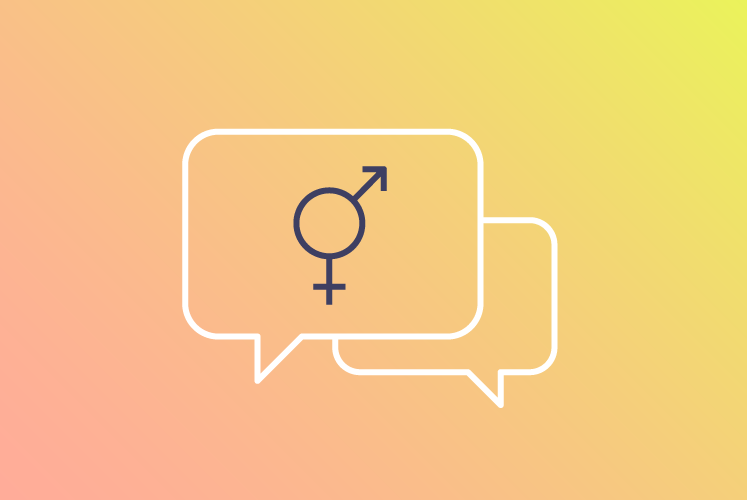A Gender Identity Glossary for Schools

How we choose to define and express our identity to ourselves and each other is important. Conversations about gender identity are becoming increasingly common in schools, and school counselors should be prepared to support students who identify as transgender or gender nonconforming. Part of this support includes understanding the language used to describe gender expression and identity so that words are not incorrect or hurtful to a student or colleague.
When thinking about these words, never assume that a student identifies with a particular label or term to describe themselves. Trust that students know themselves better than anyone and listen to what they each have to say about their gender identity and expression. When you take the time to listen and learn, you empower a student to be their most authentic self.
Below is a glossary of commonly used terms to describe aspects of gender identity and expression. Do not hesitate to ask clarifying questions about labels or acronyms and empower students to give you feedback about whether you’re using terms and pronouns correctly.
Agender
Not identifying with any particular gender; sometimes referred to as “nongender” or “genderless.” Return to glossary index
Androgynous
Describes a person who presents both or neither masculine and/or feminine characteristics. Return to glossary index
Bigender
Identifying with two genders, which can fall anywhere within the gender expansive. Return to glossary index
Cisgender
An individual whose gender identity is the same as the sex they were designated at birth. Return to glossary index
Coming Out
The process through which a person accepts and shares their gender identity or sexuality with themselves and others. Coming out can be a continual process. Return to glossary index
Deadnaming
To refer to a transgender person by the name they used before transition instead of their affirmed, chosen name. Return to glossary index
Designated Sex at Birth
The sex a person is designated at birth based on their physical characteristics. People may use the acronyms DFAB and DMAB to describe “designated female at birth” and “designated male at birth.” Return to glossary index
Gender Binary
The cultural concept of two traditional genders paired with sex, male as masculine and female as feminine. Return to glossary index
Gender Dysphoria
A diagnosis used to describe the dissonance between an individual’s designated sex and their gender identity and between physical features and their gender identity. Return to glossary index
Gender Expansive
That which demonstrates a wider and more flexible range of gender identity than the gender binary. Return to glossary index
Gender Expression
The external expression of one’s gender identity, which can include appearance, behavior, and voice. Return to glossary index
Gender-Fluid
The feeling that one’s gender identity is not fixed in time or identity. A gender-fluid person can identify as multiple genders and feel more like one or the other at different points in time; they can also identify as genderqueer. Return to glossary index
Gender Identity
A person’s sense of what gender(s), if any, with which they identify. This is a person’s internal sense and not to be confused with external expression. Return to glossary index
Gender Literacy
Developing strategies and tools to examine societal gender “rules” and think critically about these narratives. Return to glossary index
Gender Nonconforming
Expressing or identifying gender in a way outside of or beyond cultural or societal expectations for gender expression. This is an umbrella term encompassing other terms like “genderqueer,” “gender-variant” and “gender-fluid.” Return to glossary index
Gender Neutral
A term used to describe spaces, language and identities that are not gendered (e.g., a gender-neutral bathroom). Return to glossary index
Gender-Neutral Pronouns
Sets of pronouns that do not conform to the male/female binary. Also known as all-gender pronouns. Examples can include ze, hir and hirs or the singular they, among others. Return to glossary index
Genderqueer
One whose identity lies outside the gender binary of male or female. Might be used interchangeably with gender nonconforming. Return to glossary index
Gender Role
Behaviors and beliefs that a cultural group deems appropriate for people based on their designated sex. Return to glossary index
Hormone Therapy
Intentional treatment used to impact development of secondary sex characteristics. Return to glossary index
Intersex
Describes an individual born with sex chromosomes, genitalia, or reproductive system not typical for the male or female sex. Return to glossary index
Misgender
Referring to a person using a gender pronoun they do not identify with. Return to glossary index
Mx.
A gender-neutral title, pronounced “miks,” to replace gendered titles like Ms. and Mr. Return to glossary index
Nonbinary
A person who does not exclusively identify as one of the two genders on the gender binary, male or female. Return to glossary index
Outing
Revealing someone’s gender identity or sexual orientation without their permission. Return to glossary index
Passing
A transgender person’s ability to be perceived as the gender with which they identify. Return to glossary index
Polygender
Identifying with multiple genders. Return to glossary index
Pronouns
The terms a person has decided align best with their gender identity and expression of self; you should use a person’s pronouns when referring to them. Return to glossary index
Third-Gender
Describes a person who identifies not as male or female but a third gender. Return to glossary index
Transgender (TG)
Describes people who have a gender identity that is different from the sex assigned at birth. Return to glossary index
Transition
The process of a trans person coming out, which can be marked by changes in appearance, body, behaviors and how a person refers to themselves. A transition can be over a set amount of time or a continual process. Return to glossary index
Transphobia
Fear and hatred of people who identify as transgender or challenge the binary gender system. Return to glossary index
Two Spirit
A term used by Native American people for someone who possess the qualities and spirit of multiple genders. Return to glossary index
READ THE REST OF THE SERIES

How to Talk to School Staff and Parents About Gender Identity
A list of frequently asked questions that educators may receive from parents or school staff about the topic of gender identity, as well as strategies on how to shape these conversations.

A set of action steps to support educators in creating a welcoming and inclusive environment that celebrates all student differences, including gender.
Citation for this content: USC Rossier’s online masters in school counseling program.


